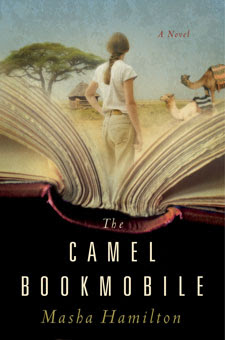 It was almost 3 years since Maude Newton first blogged about the Camel Library Service that serves the semi-nomadic people of Northeastern Kenya. Author Masha Hamilton went for a visit in early 2006 to get some first hand experience for the novel on the Camel Library Service she was working on. The book is due out in the spring.
It was almost 3 years since Maude Newton first blogged about the Camel Library Service that serves the semi-nomadic people of Northeastern Kenya. Author Masha Hamilton went for a visit in early 2006 to get some first hand experience for the novel on the Camel Library Service she was working on. The book is due out in the spring.
From Hamilton’s Story Behind the Book:
The actual Camel Bookmobile made its first run almost a decade ago. Three dromedaries trudged through arid northeastern Kenya near the unstable border with Somalia to bring a library to settlements so remote they had become nearly invisible. Lacking roads, clean water, and food, those who inhabited these villages had never been to school much less held a book in their hands. The books that came to them were rare and precious gifts, allowing them to briefly escape the reality of squalor and destitution.
The program details from the Kenya National Library Service :
-To provide access to books and other publications to the pastoralists. There is no other means of access to information in the vast plains.
-To fight illiteracy. North Eastern Province has an illiteracy rate of 85.3% as compared to the National figure of 31%.
-To support formal education. Absence of books and school libraries has contributed to escalate the problem of poor performance in National examinations. 48.4% of primary school age children are not enrolled in schools.
-To support vulnerable groups to access books, knowledge and encourage education. There is a consistent high rate of dropouts among girls as compared to boys. In most schools, there is hardly any girl child in the final class.
-To provide information to be used for leisure, knowledge and research. Most of the people in the area are generally poor and may not afford to buy textbooks and other information resource materials. More so majority of people are idle as there are no recreational facilities and therefore many of them resort to social vices.
-To stimulate public interest in books and promote reading for knowledge, information and enjoyment. Before the CLS was launched, the static library facility was inadequately used. Camels have been considered as a source of livelihood among the Pastoralists as they are useful in providing food (meat and milk); skins are used for making shoes, sleeping mats, gourds for carrying milk etc; urine is used as medicine; dung is also used as medicine, source of fuel and manure; and for transport. Therefore transporting books with the animals they identify with most enhances the usage of library materials.
-Infrastructural impediments such as poor roads have hampered transportation of information resource materials to users by motorized mobiles and hence the use of non-motorized transport – the Camel.
As you can imagine the need for material remains great. The conditions of the trek are hard and reduce the shelf-life of the books.
If you want more information on how to donate books click here. Books in English are welcome.

